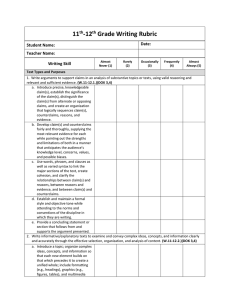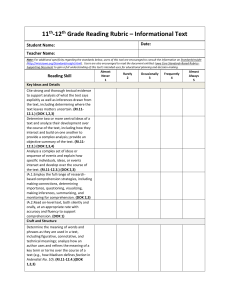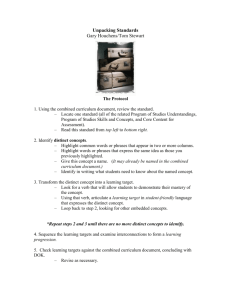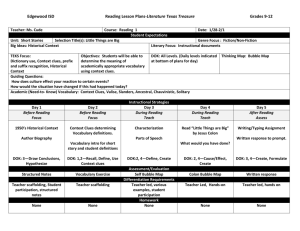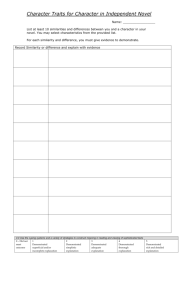5th Grade - IC Language
advertisement
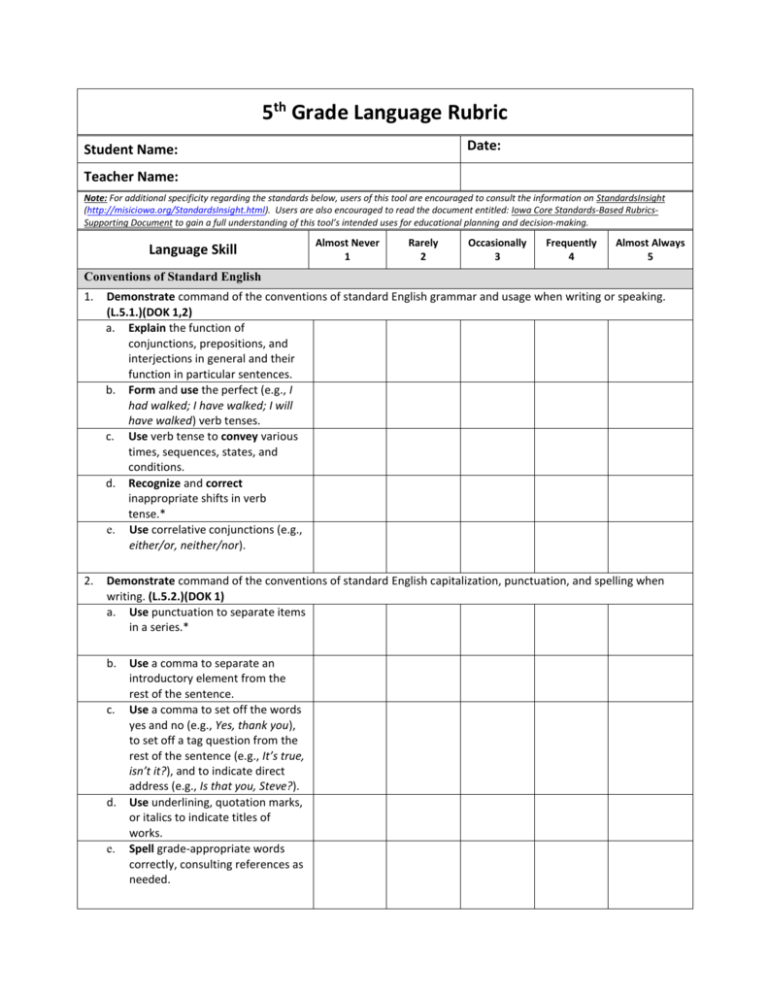
5th Grade Language Rubric Date: Student Name: Teacher Name: Note: For additional specificity regarding the standards below, users of this tool are encouraged to consult the information on StandardsInsight (http://misiciowa.org/StandardsInsight.html). Users are also encouraged to read the document entitled: Iowa Core Standards-Based RubricsSupporting Document to gain a full understanding of this tool’s intended uses for educational planning and decision-making. Language Skill Almost Never 1 Rarely 2 Occasionally 3 Frequently 4 Almost Always 5 Conventions of Standard English 1. Demonstrate command of the conventions of standard English grammar and usage when writing or speaking. (L.5.1.)(DOK 1,2) a. Explain the function of conjunctions, prepositions, and interjections in general and their function in particular sentences. b. Form and use the perfect (e.g., I had walked; I have walked; I will have walked) verb tenses. c. Use verb tense to convey various times, sequences, states, and conditions. d. Recognize and correct inappropriate shifts in verb tense.* e. Use correlative conjunctions (e.g., either/or, neither/nor). 2. Demonstrate command of the conventions of standard English capitalization, punctuation, and spelling when writing. (L.5.2.)(DOK 1) a. Use punctuation to separate items in a series.* b. c. d. e. Use a comma to separate an introductory element from the rest of the sentence. Use a comma to set off the words yes and no (e.g., Yes, thank you), to set off a tag question from the rest of the sentence (e.g., It’s true, isn’t it?), and to indicate direct address (e.g., Is that you, Steve?). Use underlining, quotation marks, or italics to indicate titles of works. Spell grade-appropriate words correctly, consulting references as needed. Knowledge of Language 3. Use knowledge of language and its conventions when writing, speaking, reading, or listening. (L.5.3.)(DOK 2,3,4) a. Expand, combine, and reduce sentences for meaning, reader/listener interest, and style. Compare and contrast the varieties of English (e.g., dialects, registers) used in stories, dramas, or poems. Vocabulary Acquisition and Use 4. Determine or clarify the meaning of unknown and multiple-meaning words and phrases based on grade 5 reading and content, choosing flexibly from a range of strategies. (L.5.4.)(DOK 1,2,3) b. a. b. c. d. 5. 6. Use context (e.g., cause/effect relationships and comparisons in text) as a clue to the meaning of a word or phrase. Use common, grade-appropriate Greek and Latin affixes and roots as clues to the meaning of a word (e.g., photograph, photosynthesis). Consult reference materials (e.g., dictionaries, glossaries, thesauruses), both print and digital, to find the pronunciation and determine or Clarify the precise meaning of key words and phrases. Demonstrate understanding of figurative language, word relationships, and nuances in word meanings. (L.5.5.)(DOK 1,2,3) a. Interpret figurative language, including similes and metaphors, in context. b. Recognize and explain the meaning of common idioms, adages, and proverbs. c. Use the relationship between particular words (e.g., synonyms, antonyms, homographs) to better understand each of the words. Acquire and use accurately gradeappropriate general academic and domain-specific words and phrases, including those that signal contrast, addition, and other logical relationships (e.g., however, although, nevertheless, similarly, moreover, in addition). (L.5.6.)(DOK 1,2) *Rating Descriptors Operationally Defined: Almost Never – grade level standard/skill is demonstrated/observed very little or not at all (with appropriate accommodations) with no generalization of skill across days and novel tasks. Rarely – grade level standard/skill is demonstrated/observed infrequently (with appropriate accommodations) with little or no generalization of skill across days and novel tasks; teacher prompting does not always result in demonstration of skill. Occasionally – grade level standard/skill is demonstrated/observed periodically (with appropriate accommodations) with inconsistent generalization across days and novel tasks; teacher prompting is often necessary for skill to be generalized. Frequently – grade level standard/skill is demonstrated/observed often (with appropriate accommodations) with consistent generalization of skill across days and novel tasks; occasional teacher prompting is necessary for skill to be generalized. Almost Always – grade level standard/skill is demonstrated/observed most of the time (with appropriate accommodations) with consistent and independent generalization of skill across days and novel tasks. Place calendar date next to the numeral to signify date of data summary, and a listing of utilized data sources, summary and next steps in the appropriate spaces Baseline Data Sources Date #1: Data Sources: Date #2: Summary: Next Steps: Data Sources: Date #3: Summary: Next Steps: Data Sources: Date #4: Summary: Next Steps: Data Sources: Date #5: Summary: Next Steps: Data Sources: Date #6: Summary: Next Steps: Data Sources: Date #7: Summary: Next Steps: Data Sources: Date #8: Summary: Next Steps: Data Sources: Date #9: Summary: Next Steps: Data Sources: Date #10: Summary Next Steps: Data Sources: Date #11: Summary: Next Steps: Data Sources: Date #12: Summary: Next Steps: Data Sources: Date #13: Summary: Next Steps: Data Sources: Date #14: Summary: Next Steps: Data Sources: Date #15: Summary: Next Steps: Data Sources: Date #16: Summary: Next Steps: Data Sources: Date #17: Summary: Next Steps: Data Sources: Date #18: Summary: Next Steps:
